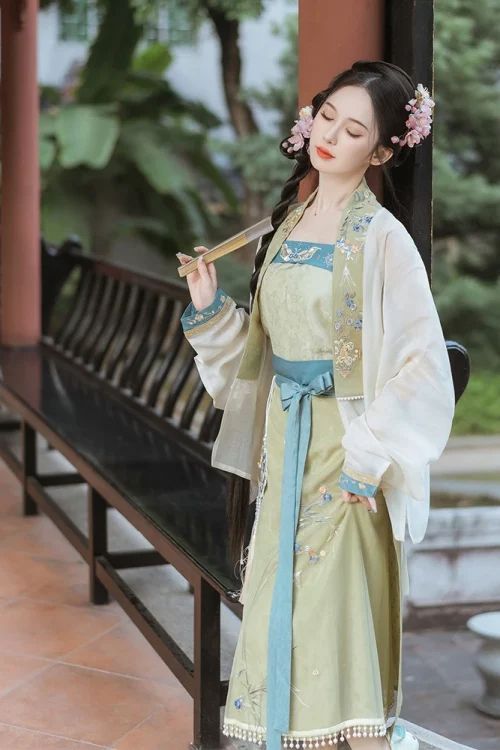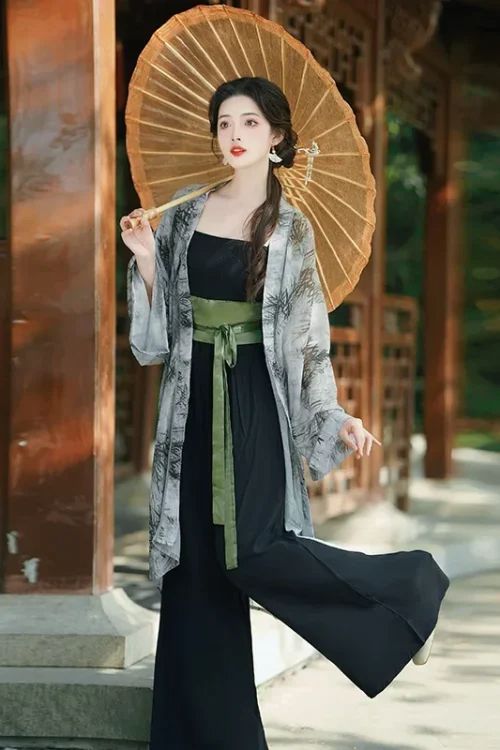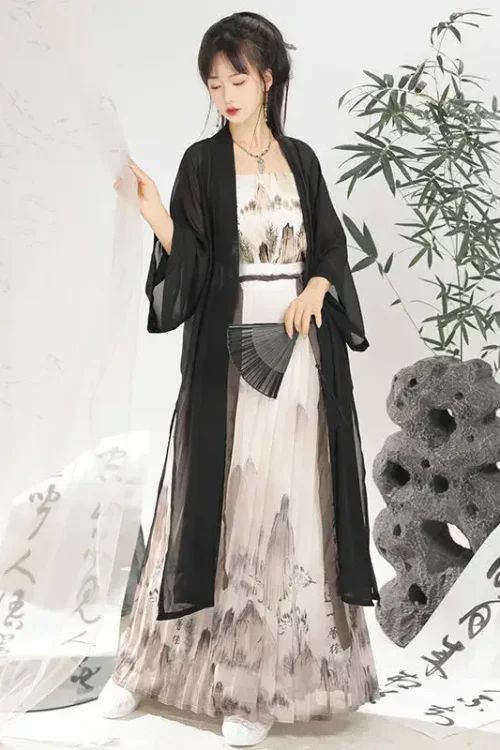Hanfu in Song Dynasty Paintings: Depictions of Elegance and Refinement
Hanfu, the traditional clothing of the Han Chinese, has played a significant role in shaping Chinese culture and aesthetics. During the Song Dynasty (960-1279), Hanfu reached its peak of elegance and refinement, inspiring numerous works of art and literature.

Exquisite Depictions in Paintings
Song Dynasty paintings often depicted Hanfu in exquisite detail, capturing the beauty and grace of the garments. Artists such as Zhang Zeduan and Li Song painted scenes of everyday life, showcasing the various styles and colors of Hanfu worn by people from all walks of life. The flowing robes, intricate embroidery, and delicate accessories depicted in these paintings convey a sense of sophistication and refinement.
Hanfu in Literature
Hanfu also influenced the development of Chinese literature. Poets and writers of the Song Dynasty used Hanfu as a symbol of beauty, elegance, and cultural identity. In the famous poem “Ode to the Red Cliff,” Su Shi describes the beauty of the Hanfu worn by the women of his time, comparing them to “flowers in the mist.”
Artistic Inspiration Beyond Paintings
The connection between Hanfu and art extended beyond paintings and literature. Hanfu was also used as a form of artistic expression in its own right. The intricate patterns and designs of Hanfu were often inspired by nature, with motifs such as flowers, birds, and mountains. The colors and fabrics used in Hanfu also reflected the changing seasons and the wearer’s personal style.
Cultural and Social Significance
In addition to its aesthetic value, Hanfu also held cultural and social significance. The different styles and colors of Hanfu indicated the wearer’s social status, occupation, and even their marital status. Hanfu was also used to mark important occasions such as weddings, festivals, and religious ceremonies.
Enduring Influence of Hanfu
The influence of Hanfu on Song Dynasty art and literature is a testament to the enduring power of Chinese culture. Hanfu not only provided a means of self-expression and social distinction but also inspired some of the most beautiful and enduring works of art and literature in Chinese history. Today, Hanfu continues to be a source of inspiration for artists and designers, and its legacy as a symbol of Chinese elegance and refinement lives on.
The Influence of Hanfu on Song Dynasty Literature: Symbolism and Cultural Significance
Hanfu, the traditional clothing of the Han Chinese, has profoundly influenced Chinese culture throughout history. During the Song Dynasty (960-1279), Hanfu played a pivotal role in inspiring both paintings and literature, becoming an integral part of the era’s artistic and literary expressions.

Visual Representation in Art
In Song Dynasty paintings, Hanfu served as a visual representation of social status, cultural identity, and personal style. Artists meticulously depicted the intricate details of Hanfu, from the flowing robes to the elaborate headwear, capturing the elegance and sophistication of the period. The vibrant colors and graceful lines of Hanfu added a sense of dynamism and beauty to the paintings, enhancing their aesthetic appeal.
Symbolic Significance in Literature
Beyond its visual impact, Hanfu also held deep symbolic significance in Song Dynasty literature. Poets and writers used Hanfu as a metaphor for cultural heritage, national pride, and personal aspirations. Wearing Hanfu represented a connection to the past and a sense of belonging to a shared cultural identity. In poems and stories, characters adorned in Hanfu often embodied virtues such as loyalty, integrity, and filial piety.
Historical Context and Authenticity
The symbolism of Hanfu extended to its use in depicting historical events and legendary figures. In historical paintings and literary works, Hanfu served as a visual and literary device to evoke a sense of authenticity and historical accuracy. By portraying characters in Hanfu, artists and writers could transport readers and viewers back in time, immersing them in the rich tapestry of Chinese history.
Aesthetic Influence on Literature
Furthermore, Hanfu played a crucial role in shaping the aesthetics of Song Dynasty literature. The flowing robes and elegant silhouettes of Hanfu inspired poets and writers to create lyrical descriptions of beauty and grace. The intricate patterns and vibrant colors of Hanfu provided a rich source of imagery, enriching the sensory experience of reading Song Dynasty literature.
Conclusión
In conclusion, Hanfu was not merely a form of clothing during the Song Dynasty; it was an integral part of the era’s artistic and literary expressions. Through its visual representation in paintings and its symbolic significance in literature, Hanfu became a powerful medium for conveying cultural identity, historical authenticity, and aesthetic beauty. The enduring legacy of Hanfu in Song Dynasty art and literature continues to inspire and captivate audiences to this day.
Hanfu as a Canvas for Artistic Expression: Exploring the Interplay of Fashion and Art
Hanfu, the traditional clothing of the Han Chinese, has long been a source of inspiration for artists and writers. During the Song Dynasty (960-1279), Hanfu reached its peak of elegance and sophistication, becoming an integral part of the era’s artistic and literary landscape.

Vibrant Colors and Intricate Patterns
The vibrant colors and intricate patterns of Hanfu provided a rich canvas for painters. Artists such as Zhang Zeduan and Li Song captured the bustling streets and serene gardens of the Song capital, Kaifeng, with Hanfu-clad figures adding a touch of authenticity and beauty to their works. The flowing robes and elaborate headdresses of Hanfu conveyed a sense of grace and refinement, reflecting the cultural values of the time.
Hanfu in Poetry
Hanfu also played a significant role in literature. Poets like Su Shi and Li Qingzhao used Hanfu as a metaphor for beauty, love, and longing. In Su Shi’s poem “Ode to the Red Cliff,” the poet describes the flowing robes of the Hanfu-clad figures as “clouds of brocade,” evoking a sense of ethereal elegance. Li Qingzhao’s poem “A Song of Everlasting Regret” features a woman who laments the loss of her lover, using the imagery of Hanfu to convey her sorrow and longing.
Cultural Significance of Hanfu
The interplay between Hanfu and art during the Song Dynasty was a testament to the cultural significance of this traditional clothing. Hanfu not only served as a practical garment but also became a symbol of beauty, refinement, and cultural identity. Artists and writers found inspiration in its vibrant colors and intricate patterns, using Hanfu to express their emotions and depict the world around them.
Contemporary Relevance of Hanfu
In contemporary times, there has been a renewed interest in Hanfu, both as a fashion statement and as a source of cultural pride. The vibrant colors and elegant designs of Hanfu continue to captivate artists and designers, who incorporate elements of Hanfu into their works. Hanfu has also become a popular subject for photography, with enthusiasts capturing the beauty and grace of this traditional clothing in stunning images.
Enduring Legacy of Hanfu
The enduring legacy of Hanfu in art and literature is a testament to its timeless appeal. From the paintings of the Song Dynasty to the contemporary fashion scene, Hanfu continues to inspire and captivate, serving as a bridge between the past and the present, and a symbol of the rich cultural heritage of the Han Chinese people.
